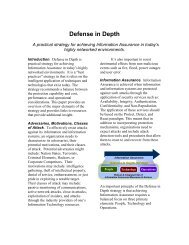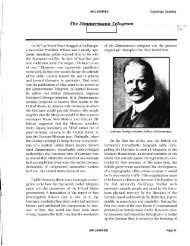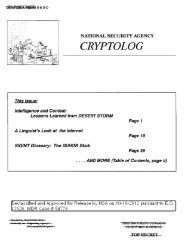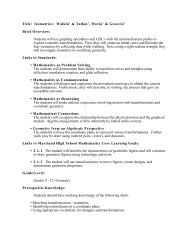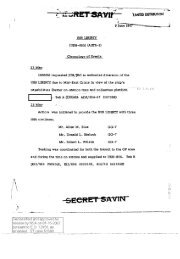Title: Talking with Machines--Binary Conversions Brief Overview ...
Title: Talking with Machines--Binary Conversions Brief Overview ...
Title: Talking with Machines--Binary Conversions Brief Overview ...
Create successful ePaper yourself
Turn your PDF publications into a flip-book with our unique Google optimized e-Paper software.
Hexadecimal Number System<br />
Hexadecimal Number System -- A number system, having a base of 16. Convenient<br />
for representing 4 bit numbers. Digits are 0 through 9 and A through F.<br />
The hexadecimal system was named from the prefix hexa which stands for six and decimal<br />
which implies ten. The first ten digits are the same as the decimal system (0-9). However,<br />
for the decimal numbers 11-15, the hexadecimal number system uses the letters A - F.<br />
Since many personal computers today use a 16-bit assembly language, the hexadecimal<br />
system has become very popular. The hexadecimal system is also more closely related to<br />
binary than decimal. Because of the large values for each digits position we will not name<br />
them below (digit name by position).<br />
Place Value by Position<br />
Exponential digit<br />
value by position 16 3 16 2 16 1 16 0<br />
We can demonstrate the value of each position(place value) by analyzing a sample decimal<br />
number.<br />
Example: 321016 = 3 x 16 3 + 2 x 16 2 + 1 x 16 1 + 0 x 16 0<br />
= 3 x 4096 + 2 x 256 + 1 x 16 + 0 x 1<br />
= 12288 + 512 + 16 + 0<br />
= 12816 10<br />
This example illustrates one way to convert a hexadecimal number to its equivalent decimal<br />
value.<br />
Chalkboard Examples:<br />
Try converting the following hexadecimal numbers to decimal.<br />
Answers: 96110, 105010, 794210<br />
3C1 16 41A16 1F0616






